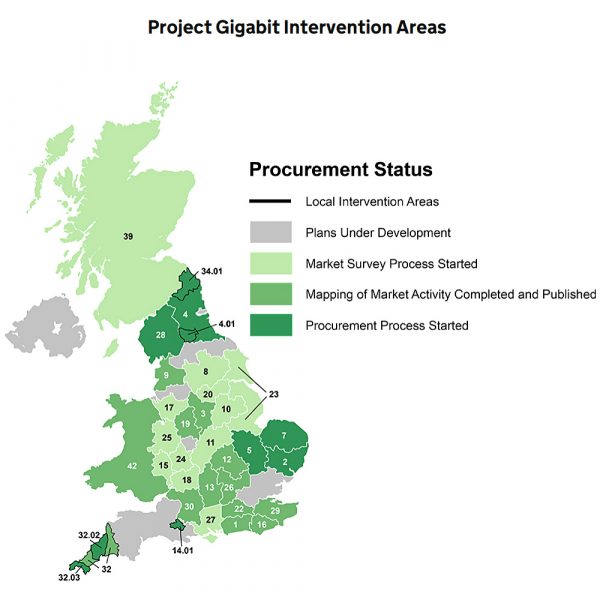UK Gov Respond to NIC’s Call for Clearer Gigabit Broadband Plan

The UK Government (DCMS) has today published their response to a number of recommendations made by last year’s National Infrastructure Commission‘s (NIC) report into Infrastructure, Towns and Regeneration (here), which called for better mobile coverage data, a clearer gigabit broadband plan and more effort to boost take-up.
Just to recap. The £5bn Project Gigabit programme is designed to extend gigabit broadband (1Gbps) speeds to reach at least 85% of UK premises by the end of 2025, before hopefully achieving “nationwide” coverage (c. 99%) by around 2030 (here). Work on this is currently underway and quarterly updates are already being published, with the first contracts due to be awarded very soon.
Last year also saw the Gigabit Take-Up Advisory Group (GigaTAG), which is supported by Which?, Ofcom, the FSB, CBI and others, set out what they think the UK Government needs to do (here) in order to boost the take-up of related services (e.g. clearer labelling of products and more advertising campaigns). However, we haven’t seen much progress on those recommendations, yet.
Advertisement
The NIC’s report, which also covered transport, sought to make a series of recommendations on how to maximise the benefits of related infrastructure policy and investment for towns in England. The Government’s response to this has now been published (here), although it largely just serves to highlight the work they’re already doing and doesn’t add much in the way of new information.
We’ve summarised three of the key responses below, but due to travel requirements that’s about all we have time for this afternoon.
Government’s Response to NIC Report
Recommendation 5
“The government should set out a clear plan, with milestones and funding, for delivery of gigabit broadband to the hardest to reach premises that will require public subsidy. In those towns where there are likely to be gaps in commercial rollout, and where the government’s regional procurement programme is scheduled to start later, the government should work with local authorities and operators to identify opportunities for local solutions and facilitate voucher funded projects to accelerate coverage wherever possible.”
The government accepts this recommendation, which is already being fulfilled by Building Digital UK’s (BDUK) Quarterly Updates and the publication of the Corporate Plan for 2022-23, the latter of which set out BDUK’s delivery plans up to the end of 2025. The government considers digital connectivity essential to closing the digital divide and supporting the government’s levelling up missions. That is why the government has committed a landmark £5 billion Project Gigabit to support the rollout of gigabit connectivity in the hardest to reach areas, with a target for at least 85% of the UK to benefit from gigabit-capable connectivity by 2025. To date, 69% of the UK is covered by gigabit-capable broadband.
BDUK is in the process of mapping telecoms operators’ commercial plans across the UK to identify those premises that will require public subsidy, and will have launched the data collection process for more than 95% of the UK by the end of 2021-22. BDUK expects that up to 20% of UK premises will not be reached by the private sector alone. This figure includes the subset of towns referred to by the NIC.
Through Project Gigabit, the government is running procurements across the UK, designed to target premises in each area that fall outside of commercial build plans to enable nationwide coverage of gigabit-capable networks. By targeting uncommercial premises, including those in urban and rural locations, Project Gigabit can ensure these premises are connected to gigabit-capable broadband while maintaining value for money and avoiding the displacement of private investment.
In denser urban areas, the government is predominantly expecting telecoms operators to provide gigabit connectivity without government support. As advanced in the recommendation, BDUK already offers vouchers for a gigabit-capable connection that can be used by business and residential premises in rural locations (including small towns) to encourage suppliers to extend broadband networks to their premises. BDUK’s recently published Performance Report showed 89% of all premises passed by BDUK were rural premises in 2021-22. The latest information on BDUK procurements is available in BDUK’s 2022 Spring Update.
The government is also working on barrier-busting activities that will support these commercial plans in towns. For example, provisions in the Telecommunications Infrastructure (Leasehold Property) Act 2021 will enable telecoms operators to benefit from a fast-track process for interim access rights when landowners of multi-dwelling units are repeatedly unresponsive. Making this process more efficient should help address the issue identified by the NIC that unresponsive landlords can make it difficult to obtain access through the wayleave process. Additionally, provisions in the Product Security and Telecommunications Infrastructure Bill intend to better facilitate consensual agreements between landowners and operators and encourage more effective engagement. Both pieces of legislation are designed to improve communication between parties, and ultimately support faster gigabit connectivity to urban areas.
Recommendation 6
“The government should develop a strategy by 2022 for encouraging the take up of new communications networks and services by small and medium enterprises.”
The government partially accepts this recommendation. The government intends to set out how it will help businesses – large and small – realise the full benefits of 5G by encouraging the adoption of 5G and other forms of wireless connectivity in its Wireless Infrastructure Strategy later this year. The strategy will be relevant to small and medium enterprises (SMEs) and the government will continue to push forward with policies that support the take-up of communications networks across the UK. It is vital that the UK’s SMEs are clear about the benefits of upgraded communications networks.
The government has invested £200 million in the 5G Testbed and Trials (5GTT) Programme, which has focused on exploring the benefits and challenges of 5G across a range of use cases and geographies. The majority of businesses involved in the programme have been SMEs. The findings and lessons shared through the Programme are expected to spur further innovation and productivity improvements in a range of organisations including SMEs throughout the UK. In the long term the government also expects the extent of deployment of 5G to be increased, for example using private networks, due to the programme demonstrating the improved benefits of doing this and the reduction of deployment costs, meaning more people and organisations will benefit from this transformative technology.
The first Interim Evaluation Report of the 5GTT Programme was published in 2020. The programme enabled SMEs involved to de-risk investments in 5G communication networks and participants who had not previously used wireless connectivity solutions committed to work with 5G technologies following the programme’s closure. The government has also launched the 2022 Interim Evaluation for the programme and expect this to be completed by April 2023. The government will share findings with SMEs demonstrating the possibilities that 5G adoption could have for their businesses, alongside updates on GOV.UK.
In the case of gigabit broadband, the government is taking steps to address the barriers to network adoption identified by the Gigabit Take-Up Advisory Group (GigaTAG) and referenced by the NIC. Regarding the NIC’s first two barriers on a lack of understanding and awareness of gigabit connectivity and its benefits, Building Digital UK are developing new broadband toolkits for LAs to help them raise awareness of the publicly funded gigabit broadband rollout in their areas. Work is also being taken forward by Ofcom to improve the consistency of broadband terminology and information to aid more widespread understanding. Regarding the NIC’s third barrier to network adoption, on a lack of digital skills slowing SME gigabit adoption, the government is supporting digital skills through the Help to Grow scheme, the globally competitive visa scheme set out in the Plan for Growth and via significant investment in education, such as the £117 million announced at Spring Statement 2022 to create 1,000 new AI PhDs through Centres of Doctoral Training.
Given the government’s existing and forthcoming work, including UK5G and the Department for Business, Energy & Industrial Strategy’s Made Smarter programme that have helped SMEs utilise new communication networks, the government does not agree that there is a specific need to develop a standalone strategy for this. The government will, however, ensure that work in this area is coordinated, well targeted and continues to keep pace with further communication network developments. This approach will ensure that SMEs can harness the productivity benefits offered by modern communication networks, both now and in the future.
Recommendation 7
“Ofcom and the government should consider real world user experience data, alongside prediction models, to improve the understanding of how people experience mobile connectivity in different places and identify any significant patterns that need to be addressed. As part of this, consideration should be given to whether Ofcom’s existing reporting on user experience can be extended to provide a more granular view of localised mobile user experience.”
The government agrees with the recommendation and supports Ofcom’s work to provide up-to-date mobile coverage information. This information is published by Ofcom based on data supplied by operators. Ofcom is undertaking a programme of work to establish how it should report on the availability and quality of 4G and 5G coverage. This will involve Ofcom working with industry to explore how different sources of real-world data can provide consumers with more accurate information on mobile connectivity and performance. Ofcom intends to report on this work in late 2022.
Mark is a professional technology writer, IT consultant and computer engineer from Dorset (England), he also founded ISPreview in 1999 and enjoys analysing the latest telecoms and broadband developments. Find me on X (Twitter), Mastodon, Facebook, BlueSky, Threads.net and Linkedin.
« BT TV Box Pro Customers in the UK Get Aerial-Free TV Access
UK ISP Options on Openreach’s FTTP Broadband Network – 2022 »























































Always amusing to see Govt claim delivery of the 85%, when in fact it’s pretty much entirely the private sector.
With the data that BDUK must hold from all of their benchmarks, tenders, testing the market etc. in 2022 there is no excuse for not being able to see at a premises level, when and where you will be expecting to be able to order an fttp service.
I appreciate all the caveats on project delivery etc. but it some info is better than no info or by 2026.
Even with all the data, Bduk will still use taxpayer money to overbuild on providers anyway
At the rate the gov. programme is going, Full Fibre (Fibre Heroes) will have built their network in my area, before procurement has even started.
A sceptical person might think they are deliberately going slowly in some areas, to see what private companies and private investment can manage on their own.
Isn’t that a good thing?? Why would you want the Govt to spend taxpayers’ money on uareas that the private sector will cover?
Because what is the point of having a government programme at all, if they ultimately don’t work fast enough for many people to benefit (I’m talking several years or more).
Your argument is basically – People and the economy can wait.
No my argument is that government should start in places where the private sector definitely won’t go. Which they don’t do.
I agree with you on that, it would make sense. There’s clearly some areas where plans are still in development (wasn’t project Gigabit originally announced in 2019?).
Ooh, look at the big light green patch at the top of the map, Last in line and destined to be, the ones left with no improvement at the end.
Recommendation 7 is essential. OFCOM official data shows I have good 4g connectivity in my house from all providers but I don’t (and its not because I live in an old brick building its a 70s property). To be honest its not good outside the house either (8Mbit max). I basically can get EE or 3 even though all providers state I have good service. I suspect I known the reason – its because my road is in the shadow of a hill that has mobile masts on top but just over the other side of the summit to cover more of the town. I’ve had issues with smart meter installs as they say I have the signal for one but then it doesn’t have a signal when they come to install. What’s the point in this data if its wrong? OFCOM don’t even provide a way to tell them the data is wrong on their official maps which would at least help the issue!